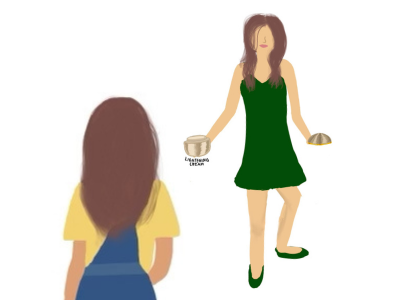Colorist beauty standards create shadows of self

Graphic illustration by Jasmine Rihal, Nicole Ge and Eileen Zhu
To conform with warping beauty standards and societal norms, youth fall into a spiral of lightening products.
June 2, 2023
In 2022, the global market of the skin-lightening industry had an estimated value of $8.8 billion. Through incessant advertising and marketing, beauty consciousness has skyrocketed across communities of color, promoting the narrative that darker complexions are inferior to lighter-skinned counterparts. Colorism, a term coined by novelist Alice Walker in 1982, is defined as a preference for lighter skin between and within different ethnic minorities. Its roots are entrenched in communities across many communities of color worldwide.
Although European colonialism significantly influenced beauty standards worldwide, colorist mindsets predate Western contact in many countries. Historically, skin tone has largely been associated with social standing. For example, in South Asia and Latin America, tanner skin was often a result of working labor jobs in strenuous heat, which is why those with darker complexions are often associated with the lower class. Individuals in the upper echelons of society had the privilege of staying inside and working white-collar jobs. Consequently, having lighter skin is associated with prestige or higher status.
When enslavement was institutionalized in the U.S., having a lighter complexion was one of the contributing factors that granted slaves preferential behavior. Lighter-skinned individuals were often able to work less demanding jobs indoors, having a closer proximity to whiteness, while darker-skinned slaves were forced to work more grueling tasks outside. Furthermore, many white slave masters had children with their servants — thus, biracial slaves held certain privileges granted by their slave owners.
“There was a study in the late 70s that said African American children associated darker skin with more ‘negative’ traits,” colorism researcher Danielle Stamps said. “If they had a preference, they usually chose the lighter skin.”
Racial hierarchies and colonialism have heavily influenced beauty standards worldwide. Such attitudes established a widespread link between whiteness and beauty, imposing eurocentric beauty standards that projected the ideal of whiteness onto people of color, who did not have these features. For instance, due in part to American colonialism from 1898 to 1946, Indigenous communities in the Philippines were conditioned to revere whiteness through images of Christian figures and Hollywood celebrities. Whiteness soon became synonymous to not only beauty, but also wealth, intelligence and power.
Media is a leading propagator of colorism in its various mediums. In the South Asian movie and television industries, for instance, lighter skinned actors almost always receive preferential treatment when hired, and are often cast as the conventionally attractive character over darker skinned individuals who experience job disparities due to their complexion. Similarly, in American entertainment, many characters meant to be darker-skinned are still played by biracial actors with lighter complexions. Moreover, in the Philippines, many actresses and beauty pageant winners are half white or have eurocentric features to mirror the whiteness which is associated with beauty and power. In fact, six out of the past 10 winners of the Miss World Philippines titleholders have white ancestry.
“There is a feedback loop where the people who control media select performers with a particular beauty standard, which then is broadcast, then defining the beauty standard,” said American Literature teacher David Bulone.
Similarly, in Latin America, lighter-skinned individuals often appear as the most affluent, politically powerful figures and are represented in formats such as the extremely popular telenovelas.
In the service industry, employers tend to favor lighter-skinned applicants as their job requires interaction with customers and are viewed as a better representation of their brand. Moreover, colorist prejudices can even influence healthcare. According to a 2021 study in the Journal of Social Issues and Public Policy, African American individuals and patients with darker skin are often subject to prejudiced treatment from healthcare workers, leading to inadequate healthcare outcomes.
Colorism has also driven hierarchies within racial groups. For instance, during the 20th century, the Brown Paper Bag test was administered within African American communities to confirm entrance into beneficial social institutions. Those with a complexion lighter than a paper bag would be granted more privileges such as access to more resources and public spaces.
“They had to pass in order to be inserted into a high African American society,” Stamps said. “I would fail the paperback just because I’m darker than a paper bag because that’s more of a caramel color.”
The reinforcement of colorism causes many to resort to bleaching their skin to fit the media’s standards.
“Lightening products are common in all stores, but especially in India,” sophomore Sia Gupta said. “You’ll see tons and tons of brands specifically for skin lightening. They’re also being advertised all the time — they’re everywhere.”
Colorism persists through the promotion of Fair and Lovely, an Indian skin-whitening lotion brand making $317 million annually and advancing the growing multi-billion-dollar skin-whitening industry. Though change in the company has trickled from accusations of marketing whiteness, leading to their rebrand as Glow and Lovely, the paradigm for light skin stays prevalent in Indian culture. Additionally, while some skin treatments can be harmful, such as mercury and hydroquinone, which are both linked to bodily damage, many people are still determined to lighten their skin at the expense of these health hazards. Others opt for temporary alternatives for creating the perception of lightening skin. For instance, Douyin, a Chinese entertainment app with over 730 million monthly users, includes an automatic whitening beauty filter which applies to any skin recorded on the app.
“I lived in India for five years before I came here,” Gupta said. “Even as a kid, I was always worried about getting tan, or thought being complimented for my lighter skin was something to be proud of.”
Beauty standards in the U.S. and the rest of the world may be vastly different, but the majority hold a proximity to whiteness in high regard.
“It’s kind of detrimental since it’s not something that you can control.” Gupta said. “People shouldn’t have to worry about the color of their skin to meet a built-in standard.”




























































